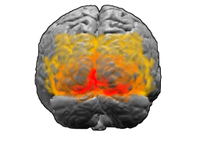
Photo from wikipedia
Experience-dependent cortical plasticity is a pivotal process of human brain development and essential for the formation of most cognitive functions. Although studies found that early visual experience could influence the… Click to show full abstract
Experience-dependent cortical plasticity is a pivotal process of human brain development and essential for the formation of most cognitive functions. Although studies found that early visual experience could influence the endogenous development of visual cortex in animals, little is known about such impact on human infants. Using the multi-modal MRI data from developing human connectome project, we revealed the early structural and functional maps in the ventral visual cortex and their development across the first month of age. Particularly, we found the postnatal experience could modulate both the cortical morphology in ventral visual cortex and the functional circuit between bilateral primary visual cortices. But the cortical myelination and overall functional circuits of ventral cortex, particularly that of the high-order visual cortex, developed without significant influence of postnatal experience in such early period. These experience-dependent cortical properties were further validated in the preterm-born infants who have longer postnatal time but immature cortical development at birth. The results confirmed that the development of cortical thickness was dominated by the postnatal experience but the functional circuit might be determined by the overall maturity of visual cortex. These data suggest in human newborns that early postnatal experience shapes the structural and functional development of the visual cortex in selective and organized pattern.
Journal Title: eLife
Year Published: 2022
Link to full text (if available)
Share on Social Media: Sign Up to like & get
recommendations!